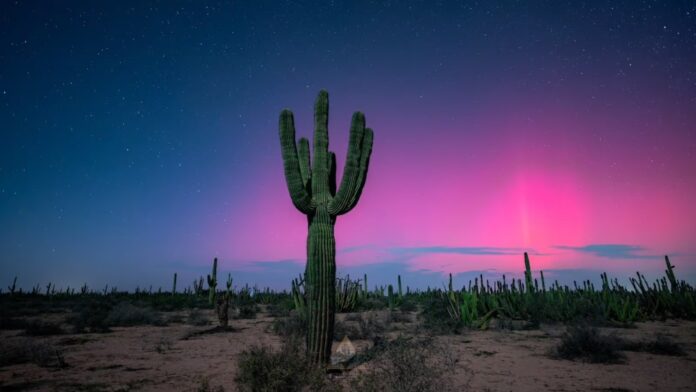The Sonoran Desert, located in Mexico, was the perfect place to appreciate the Northern Lights: The sky transformed from blue to pink and violet.
Did you see them? The Sonoran Desert, located in northern Mexico, was the perfect place to appreciate the Northern Lights that illuminated the sky in various shades on the night of Thursday, October 10.
These luminous phenomena amazed the inhabitants of Sonora due to the geomagnetic storm currently affecting the Earth, which is said to be one of the most intense in the last 20 years.
Although initially it was thought that this phenomenon would not be visible to the naked eye, as it required low light and long exposure photographs to capture the images, the photographer Gerardo, better known on X (formerly Twitter) as @GGerardox2, managed to capture the exact moment when the sky transformed from blue to pink and violet.
If you didn’t have the chance to appreciate the Northern Lights, take note because this spectacle will repeat on the night of Friday, October 11, in several countries around the world, including Mexico. However, it is possible that the regions most affected might experience electrical wiring issues.
Where will the Northern Lights be visible on Friday, October 11?
In recent years, the Northern Lights have been seen in countries like the United States, Canada, Norway, Portugal, Spain, and Ireland. However, this phenomenon is usually observed in the northernmost regions of the planet, although when storms are this large, they can be seen in southern regions like Mexico.
For this reason, it is possible that the Northern Lights will persist at least until this Friday, providing another opportunity to capture the phenomena while there is more sunlight.
According to experts, the best conditions to appreciate this phenomenon will be in places with low light pollution, such as Sonora, Chihuahua, Coahuila, and Nuevo León, states where this celestial spectacle can be witnessed.
Therefore, we recommend seeking dark and clear places for a better view.
What are the Northern Lights?
Galileo Galilei, an Italian astronomer, coined the term aurora in 1619, in honor of the Roman goddess of dawn, believing it was the reflection of sunlight in the atmosphere.
However, according to National Geographic, both the aurora borealis and the aurora australis are due to the interaction of gases in the Earth’s atmosphere with the solar wind, which is a stream of electrically charged particles, called ions, that are ejected from the sun in all directions.
“When the solar wind reaches the Earth, it collides with the planet’s magnetic field, producing currents of charged particles that flow towards the poles.
“Some of the ions get trapped in a layer of the atmosphere called the ionosphere, where they collide with gas atoms (mainly oxygen and nitrogen) and ‘excite’ them with extra energy. This energy is released in the form of light particles or photons,” explains National Geographic.
Source: El Financiero






